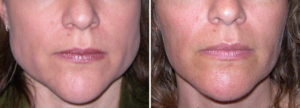Bruxism is the medical term for grinding or clenching your teeth. While it is usually called bruxism or grinding when this excess muscle activity occurs at night, it is called clenching when it occurs during the daytime. The exact cause of this overactive masseter muscle action is not precisely known but it is usually attributed to stress or tension for lack of a better understanding of the root cause.
In severe and continuous cases, secondary medical problems will occur. Most commonly, muscle fatigue, pain and headaches are common. Ultimately, tooth damage may occur from the wear on the occlusal surfaces. Traditional therapies include night time splints to protect the teeth and medications that attempt to decrease inflammation in the muscle or cause it to relax through a sedative approach. Other well known therapies include biofeedback, thermal applications, and even acupuncture. The fact that there are many different approaches is a testament that there is not one universal treatment that consistently works.
The target of any masseter hyperactivity treatment is to break the muscle spasm and weaken its clenching effect. In this regard, Botox would seem to be a very targeted approach to that goal…in the shortest period of time. Provided that the muscle area at fault can be precisely identified by feel, it can be quickly and precisely injected. The goal is to break the spastic part of the muscle, not prevent the majority of the muscle from moving. Once the focal part of the muscle is weakened, excessive contraction is stopped and the pain should decrease as the clenching subsides.

The dose of Botox to use should be around 25 to 35 units per each masster muscle as the starting dose. While it may ultimately require a higher dose than that to get an optimal response, this is a good starting dose for safety and economic reasons (insurance will not pay for these injections) If no relief is obtained at this starting dose, then this indicates that Botox is not likely to work and higher dosing may be a wasted effort and expense.
The use of Botox in the masseter muscle is not new. It has been used in Asia and the Pacific Rim for years as a method of reducing masseter muscle size for cosmetic purposes.
Like cosmetic Botox injections, the benefits are not seen immediately. Botox does not kick in for about a week after injection. For this reason, I like to mix Marcaine (a 24 hour lasting local anesthetic) and Kenalog (10mg/ml), with the Botox to get a more prompt pain-reliefing effect and help reduce muscle inflammation. One should expect Botox to last about 4 months or so. When the discomfirt starts to return, you will know it is time for another injection session.
Dr. Barry Eppley
Indianapolis, Indiana


